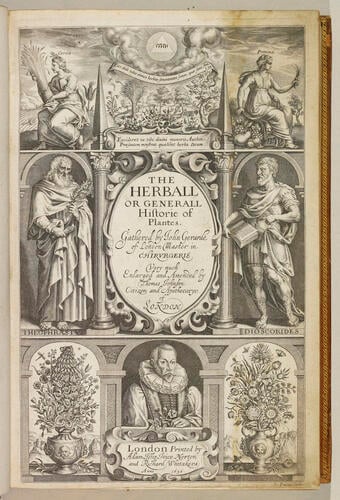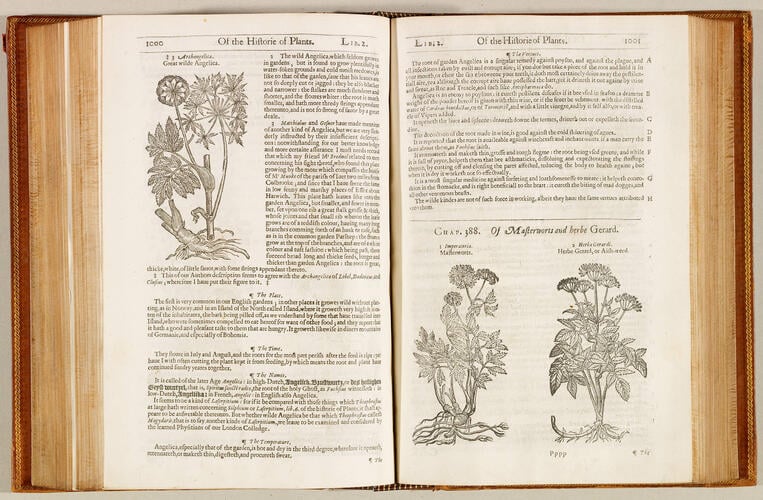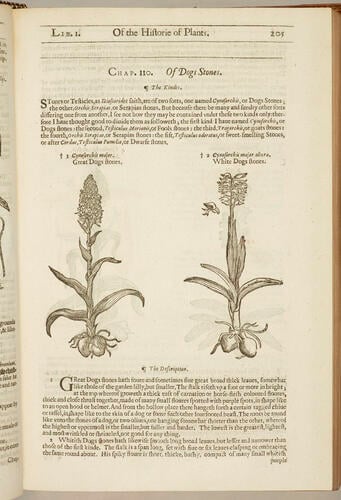-
1 of 253523 objects
The Herball, or, Generall historie of plantes 1636
35.3 x 24.0 x 8.1 cm (book measurement (conservation)) | RCIN 1057467

John Gerard (1545-1612)
The Herball, or, Generall historie of plantes / by John Gerarde ; edited by Thomas Johnson 1636

John Gerard (1545-1612)
The Herball, or, Generall historie of plantes / by John Gerarde ; edited by Thomas Johnson 1636



-
This is a copy of Gerard’s Herball, the most famous of English herbals, renowned for its numerous illustrations and its lively style with anecdotes drawn from folklore.
A herbal is a book which records and describes the medicinal properties of plants. This herbal was first published in 1597, and was written by John Gerard, a surgeon and gardener, who managed both his own gardens in London and those belonging to William Cecil, Lord Burghley. Gerard was not a botanical scientist, so he combined text and illustrations from many published sources alongside using his own knowledge when composing his Herball. It was thanks to his inclusion of anecdotes of his gardening successes and failures, and the stories he added from those he had met on his travels, that his book was such a popular addition to many libraries and households.
This is a 1636 reprint of the revised 1633 edition, edited by Thomas Johnson. An apothecary who was a more scholarly amateur botanist than Gerard, Johnson produced a very different version of the Herball. He included 800 new plant species and replaced the illustrations, which had in some cases been mislabelled. He added many asides, indicated by printer's marks, clarifying and correcting Gerard's text.
Gerard gives the rose high importance in his book, highlighting its symbolic link to royalty. He recounts a tale of a ploughed field spontaneously growing roses year after year, but Thomas Johnson’s edits point out that the flowers must have been poppies. Johnson is also scornful of Gerard's witness accounts of the barnacle goose, where driftwood is thought to grow goose eggs from which goslings of the breed would hatch. This was a traditional explanation for how barnacle geese produced young at a time when the migration of birds was not widely understood, but Johnson debunks the myth with a more scientific account of the geese having been observed laying and hatching eggs on remote islands.
Newly discovered foods from the Americas are included among the plants represented in this herbal. The description of the cacao bean, from which chocolate is derived, is less than enthusiastic: 'The cacoa is a fruit well knowne in divers parts of America, for they in some places use it in stead of money, and to make a drinke, of which, though bitter, they highly esteeme … the fruit is ... of an astringent and ungratefull taste.' Also to be found is a description of the potato plant, which Gerard describes successfully growing in his own garden. His explanations of how the vegetable could be eaten, and its perceived medicinal properties, are followed by a later note by Thomas Johnson, who records that at one point potatoes were banned in Burgundy for fear they were a cause of leprosy.
Although Thomas Johnson's alterations added more scholarly descriptions at a time when Britain was on the cusp of a scientific enlightenment, the Herball's enduring appeal lies in John Gerard's engaging text, full of personal accounts, and his descriptions rooted in folklore.
This copy shows signs of having been used by people living in the seventeenth century: it has been annotated with alternative names for some of the plants, with additions having also been made to the index.
For another copy, thought to have belonged to Charles I, see RCIN 1057110.Provenance
Acquired by William IV, 1830-37
-
Creator(s)
Acquirer(s)
-
Measurements
35.3 x 24.0 x 8.1 cm (book measurement (conservation))
Markings
annotation: Bookseller's mark?: "[line] / G / [line]" [verso 1st fly leaf]
annotation: "C&P" [verso 6th fly leaf]
annotation: Alongisde index entry for 'Barba Capri': "Barba foris. 510." [p. [4] after p. 1630, In hand which used ink which now shows as black]
annotation: Alongside index entry for 'Cauler apum': "Caulis. 316." [p. [5] after p. 1630, In hand which used ink which now shows as black]
annotation: Alongside index entry for 'Corona fratr. Terræ': "Virginea. 895." [p. [6] after p. 1630, In hand which used ink which now shows as black]
annotation: Alongside index entry for 'Herba Ægyptia, Caneri': "Camphorata — 1109". [p. [8] after p. 1630, In hand which used ink which now shows as black]
annotation: Alongside index entry for 'Lotus herbaincana': "vrbana / 1195." [p. [10] after p. 1630, In hand which used ink which now shows as black]
annotation: Alongside index entry for 'Panaces velpanax, Heracleum': "Pancarpus. V. / chamæleon / niger." [p. [12] after p. 1630, In hand which used ink which now shows as black]
annotation: Alongside index entry for 'Pituitaria': "Pithyusa. 502." [p. [12] after p. 1630, In hand which used ink which now shows as black]
annotation: Alongside index entry for 'Paludosum': "corvinum. / 1195." [p. [15] after p. 1630, In hand which used ink which now shows as black]
annotation: Alongside index entry for 'Tulipa eius[que] varietates': "Tunica. 590." [p. [15] after p. 1630, In hand which used ink which now shows as black]
annotation: Alongside index entry for 'Viola autumnalis sive calathiana, Matronal': "mortuorum. / 895." [p. [15] after p. 1630, In hand which used ink which now shows as black]
annotation: Alongside index entry for 'Viperaria': "Virginia." [p. [15] after p. 1630, In hand which used ink which now shows as black]
annotation: Alongside index entry for 'Alehoose': "856". [p. [22] after p. 1630, In hand which used ink which now shows as black]
annotation: At end of index section 'S': "Sweet Trefoile 1195". [p. [29] after p. 1630, In hand which used ink which now shows as brown]
Alternative title(s)
The Herball, or, Generall historie of plantes / by John Gerarde ; edited by Thomas Johnson.